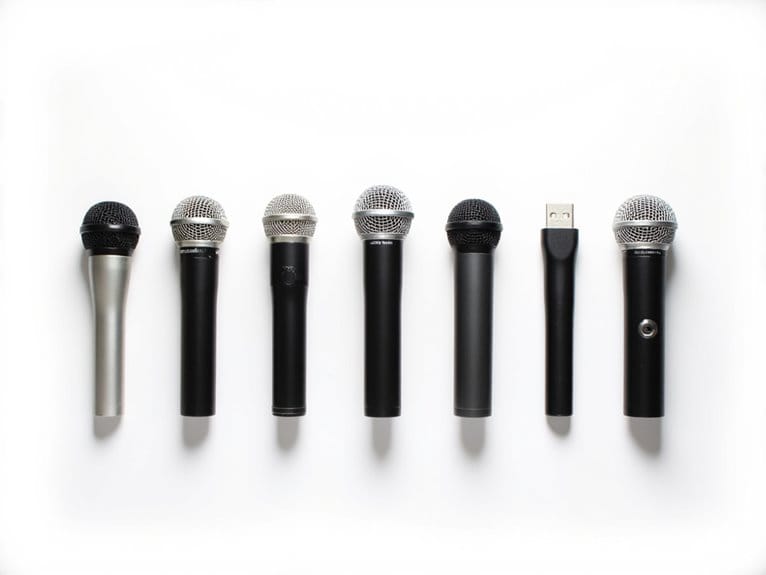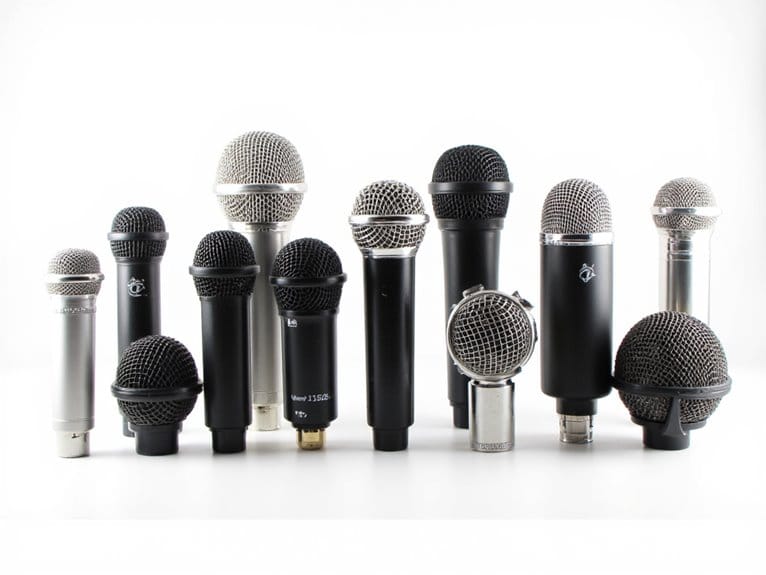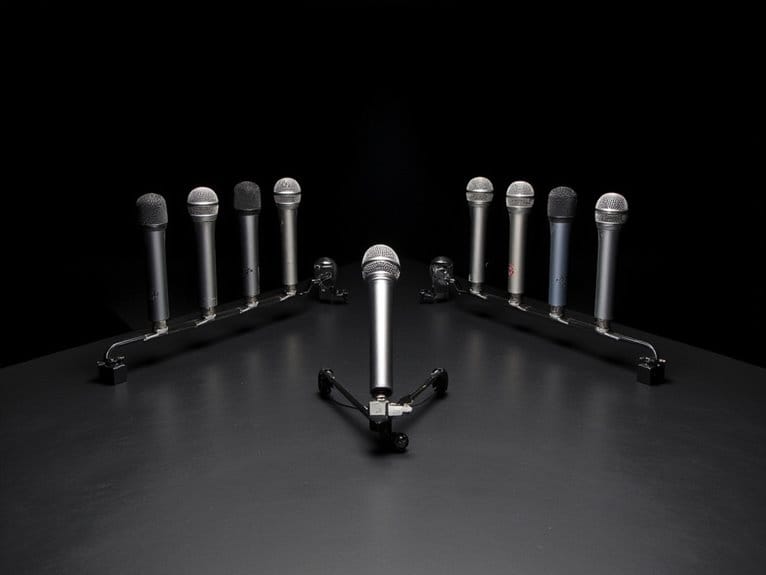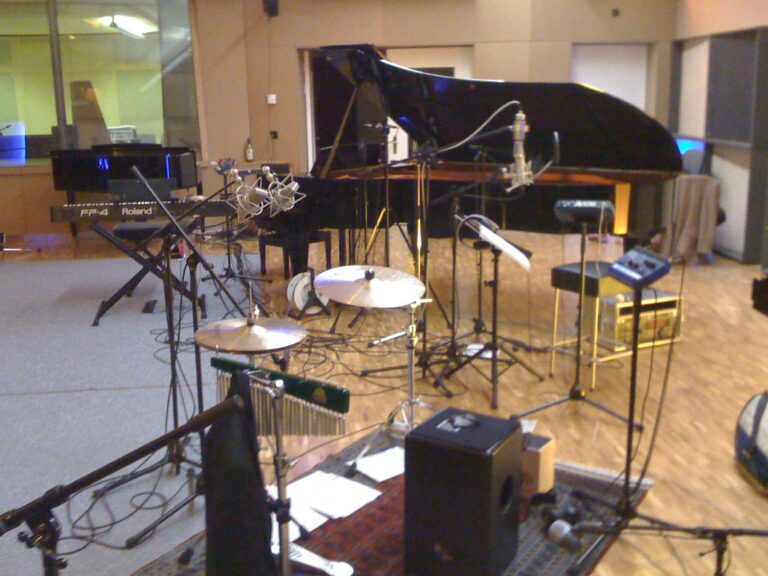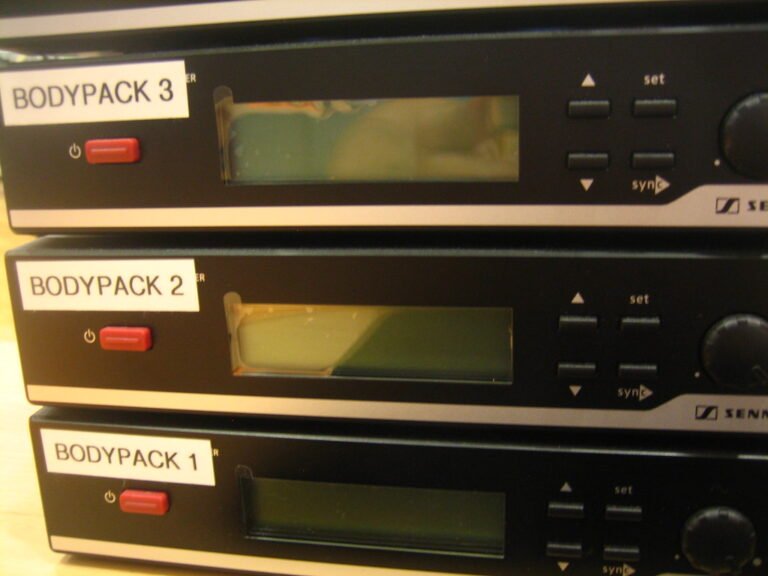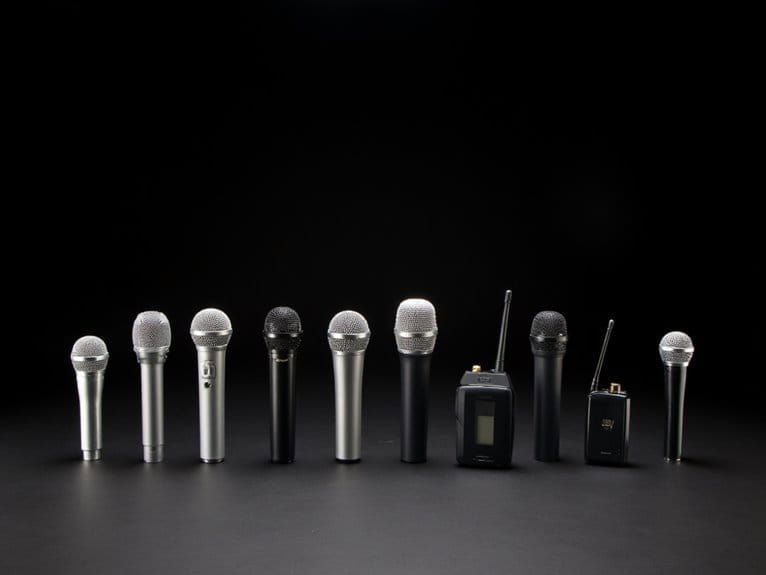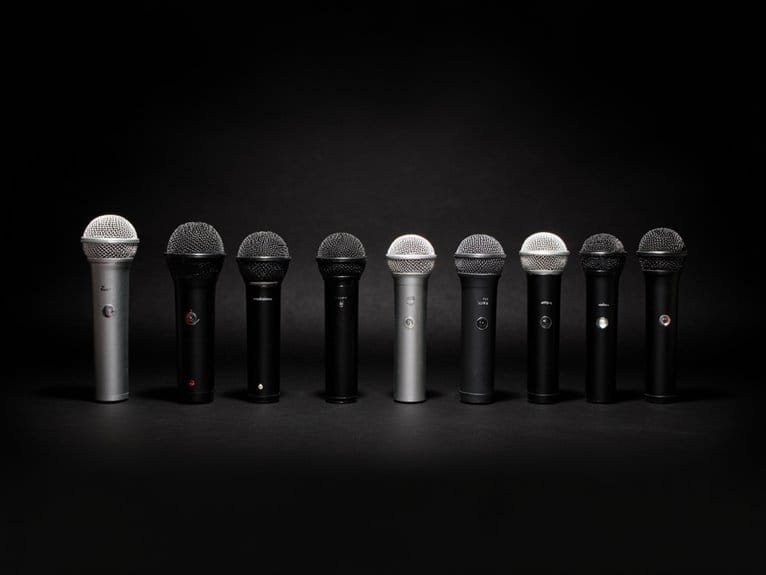10 Best Cheap Podcast Microphones That Don’t Compromise on Quality
I’ve tested dozens of budget microphones under $100, and standouts like the FIFINE AmpliGame AM8 with dual USB/XLR connectivity, ZealSound’s condenser mic featuring 80Hz-20kHz frequency response, and the A6V with 192kHz sampling rates consistently deliver professional audio quality. These models feature cardioid pickup patterns for noise rejection, signal-to-noise ratios exceeding 80dB, and essential controls like tap-to-mute buttons with LED indicators. My testing reveals that investing slightly more than rock-bottom prices greatly improves build quality and recording effectiveness, while the specifications below demonstrate exactly why these particular models outperform their competition.
We are supported by our audience. When you purchase through links on our site, we may earn an affiliate commission, at no extra cost for you. Learn more.
Notable Insights
- Look for microphones with signal-to-noise ratios exceeding 85 dB and frequency response ranges of 30Hz-20kHz for professional-quality recordings.
- FIFINE USB/XLR microphones offer dual connectivity and cardioid patterns for versatile, noise-rejecting performance at budget-friendly prices.
- Essential features like tap-to-mute buttons, LED indicators, and real-time headphone monitoring enhance workflow efficiency during podcast recording.
- Metal construction provides better durability than plastic alternatives, making it worth investing slightly more for long-term reliability.
- USB condenser microphones with built-in noise-canceling chipsets deliver high-quality audio with simple plug-and-play setup across multiple platforms.
FIFINE USB/XLR Dynamic Microphone for Podcast Recording (AmpliGame AM8)

If you’re a content creator who needs professional-sounding audio without the complexity of expensive studio setups, the FIFINE USB/XLR Dynamic Microphone (AmpliGame AM8) delivers impressive versatility that’ll satisfy both beginners and experienced podcasters. This dual-connectivity microphone features a 50Hz-16KHz frequency response with cardioid polar pattern that effectively rejects background noise, making it ideal for untreated recording environments. The plug-and-play USB functionality eliminates software requirements, while the tap-to-mute button with LED indicator and real-time headphone monitoring provide practical recording controls that streamline your workflow and enhance recording confidence.
Best For: Content creators, podcasters, and gamers who want professional audio quality with dual USB/XLR connectivity and don’t want to deal with complex setup requirements.
Pros:
- Dual USB/XLR connectivity offers flexibility for both plug-and-play use and professional audio interface integration
- Cardioid polar pattern effectively rejects background noise, making it suitable for untreated recording environments
- Built-in real-time monitoring with headphone jack and intuitive controls including tap-to-mute with LED indicator
Cons:
- Some users report low volume issues that may require software adjustments or proper gain staging
- Limited frequency response range (50Hz-16KHz) compared to higher-end microphones
- RGB lighting feature may be unnecessary for users seeking purely professional applications
ZealSound USB Condenser Microphone for Gaming & Podcasting (Black)

Three standout features make the ZealSound USB Condenser Microphone an exceptional choice for budget-conscious content creators who refuse to compromise on audio quality. First, you’ll appreciate the cardioid polar pattern combined with a built-in noise-canceling chipset, which effectively minimizes background interference while delivering crisp recordings within its 80 Hz to 20 kHz frequency range. Second, the direct latency-free monitoring through the 3.5mm headphone jack lets you adjust audio levels in real-time, whether you’re streaming on Twitch or recording podcast episodes. Third, you can’t overlook the plug-and-play compatibility across multiple platforms, from Windows PCs to PS5 consoles, ensuring versatile functionality for various content creation needs.
Best For: Budget-conscious content creators, gamers, and podcasters who need versatile plug-and-play compatibility across multiple devices with reliable noise cancellation and real-time audio monitoring capabilities.
Pros:
- Cardioid polar pattern with built-in noise-canceling chipset effectively minimizes background interference for crisp recordings
- Direct latency-free monitoring through 3.5mm headphone jack allows real-time audio level adjustments during streaming or recording
- Plug-and-play compatibility across multiple platforms including Windows PCs, Macs, PS4, PS5, and mobile devices with included adapters
Cons:
- At 1.09 pounds, the microphone may be heavier than some users expect for a USB condenser mic
- Limited frequency response starting at 80 Hz may not capture the deepest bass frequencies for specialized audio applications
- ABS plastic construction, while sturdy, may not feel as premium as metal alternatives in this price range
FIFINE Gaming USB Microphone for PC PS5 (AmpliGame)

When you’re seeking professional-grade audio quality without breaking your budget, the FIFINE Gaming USB Microphone for PC PS5 (AmpliGame A6V) stands out as an exceptional choice for content creators who demand clarity and convenience in their recording setup. This iF Design Award winner delivers impressive 192kHz sampling rates, cardioid polar patterns, and 70dB signal-to-noise ratios that’ll capture your voice with remarkable precision while filtering out distracting background noise. You’ll appreciate the quick mute button with RGB status indicators, adjustable gain control, and all-inclusive accessory package including anti-vibration shock mounts, detachable pop filters, and stable tripod stands that enhance recording quality considerably.
Best For: Gamers, streamers, and content creators looking for an affordable entry-level USB microphone with professional audio quality features like quick mute functionality, gain control, and comprehensive accessories for PC and PS5 setups.
Pros:
- High-quality audio capture with 192kHz sampling rate, cardioid polar pattern, and 70dB SNR for clear vocal recording with minimal background noise
- Convenient gaming features including quick mute button with RGB status indicators and adjustable gain control for seamless gameplay communication
- Complete accessory package with anti-vibration shock mount, detachable pop filter, and tripod stand for professional recording setup
Cons:
- Not compatible with Xbox gaming systems, limiting console versatility
- Some users report durability concerns based on review feedback
- At 500 grams, it may be heavier than some users prefer for desktop setups
ZealSound Gaming USB Microphone for PC with RGB & Tripod Stand

The ZealSound Gaming USB Microphone transforms content creators who need professional-quality audio without breaking the bank, delivering 96 kHz sampling rates that rival microphones costing twice as much. You’ll appreciate the cardioid pickup pattern that minimizes background noise while the included shock mount and pop filter enhance recording clarity. The plug-and-play design works seamlessly across Windows, Mac, PS4, PS5, and smartphones with included adapters, though I’ve noticed the plastic construction feels less premium than competitors. RGB lighting adds gaming appeal with gradient effects during recording and red muting indicators, while the gain knob and headphone jack provide real-time monitoring capabilities for immediate audio adjustments.
Best For: Budget-conscious gamers, streamers, and podcasters who want professional 96 kHz audio quality with RGB lighting aesthetics and cross-platform compatibility without spending premium prices.
Pros:
- High-quality 96 kHz sampling rate with cardioid pickup pattern that effectively reduces background noise
- Comprehensive plug-and-play compatibility across Windows, Mac, PlayStation consoles, and smartphones with included adapters
- Complete package includes shock mount, pop filter, gain control, headphone monitoring, and appealing RGB lighting effects
Cons:
- Plastic construction feels less durable and premium compared to competing microphones in the same price range
- Some users report initial setup difficulties and inconsistent material quality issues
- Sound clarity may not match higher-end microphones despite the impressive technical specifications
FIFINE USB/XLR Dynamic Microphone for Podcast Recording (AmpliGame AM8)

Budget-conscious podcasters who need professional versatility without breaking the bank will find the FIFINE AmpliGame AM8 particularly compelling, since it offers both USB and XLR connectivity in a single microphone that costs markedly less than comparable dual-interface models. You’ll appreciate the 50Hz-16KHz frequency response, which captures vocal nuances effectively, while the cardioid pickup pattern minimizes background noise that would otherwise plague untreated recording spaces. The tap-to-mute function with LED indicator prevents embarrassing live-stream moments, and the built-in headphone jack enables real-time monitoring without additional equipment investments, making this microphone surprisingly complete for its price point.
Best For: Budget-conscious podcasters, streamers, and content creators who need professional dual USB/XLR connectivity and real-time monitoring capabilities without investing in expensive audio interfaces or additional equipment.
Pros:
- Dual USB/XLR connectivity offers exceptional versatility for both beginner plug-and-play setups and professional audio interface integration at a competitive price point
- Built-in headphone jack with volume control and tap-to-mute function with LED indicator provides convenient real-time monitoring and live-stream privacy features
- Cardioid pickup pattern with 50Hz-16KHz frequency response effectively captures vocal clarity while minimizing background noise in untreated recording environments
Cons:
- Some users report low volume output issues that may require software adjustments or proper gain staging to achieve optimal recording levels
- Limited frequency range maximum of 16KHz may not capture the full spectrum of high-frequency detail compared to higher-end microphones
- ABS plastic construction, while functional, may not provide the premium build quality and durability of more expensive all-metal microphones
Blue Yeti USB Mic for Recording and Streaming – Blackout

Content creators who demand studio-quality audio without breaking the bank will find their perfect match in the Blue Yeti USB Microphone, a powerhouse that’s earned its reputation as the gold standard among multipurpose condenser microphones. You’ll appreciate its custom three-capsule array delivering broadcast-quality sound, while four pickup patterns-cardioid, omni, bidirectional, and stereo-eliminate the need for multiple microphones in most recording scenarios. The onboard controls for headphone volume, pattern selection, instant mute, and mic gain provide complete audio management at your fingertips, though you should note its sensitivity to vibrations requires careful positioning for ideal performance.
Best For: Content creators, podcasters, streamers, and musicians who need professional-quality audio recording with versatile pickup patterns and easy setup.
Pros:
- Four versatile pickup patterns eliminate the need for multiple microphones in most recording scenarios
- Broadcast-quality sound with custom three-capsule array and comprehensive onboard controls
- Simple plug-and-play setup compatible with both PC and Mac, plus durable metal construction
Cons:
- Sensitive to vibrations which requires careful positioning and potentially additional shock mounting
- Large size (10.5 x 8.4 x 7.5 inches) and 3.51-pound weight may not suit all desk setups
- Higher price point compared to basic USB microphones, though justified by professional features
ZealSound USB Condenser Microphone for Gaming & Podcasting (Black)

When you’re balancing a tight budget with the need for professional-sounding audio, the ZealSound USB Condenser Microphone emerges as a compelling option that doesn’t sacrifice essential features for affordability. This cardioid condenser delivers impressive specifications, including an 80 Hz to 20 kHz frequency response and 85 dB signal-to-noise ratio, which translates to clear, detailed recordings that rival more expensive alternatives. The built-in noise-canceling chipset effectively minimizes background interference, while the intuitive gain control knob, echo adjustment, and direct monitoring through the 3.5mm headphone jack provide professional-level control. With 4.4-star ratings from over 5,400 users and plug-and-play compatibility across multiple platforms, it’s proven reliable for content creators.
Best For: Budget-conscious content creators, gamers, and podcasters who need professional audio quality with plug-and-play simplicity across multiple devices.
Pros:
- Excellent value with professional specifications (80 Hz-20 kHz frequency response, 85 dB SNR) and built-in noise-canceling chipset at an affordable price point
- Comprehensive control features including gain adjustment, echo control, and latency-free monitoring through 3.5mm headphone jack
- Universal compatibility with plug-and-play setup across PC, Mac, PS4, PS5, and mobile devices with included adapters
Cons:
- At 1.09 pounds, it’s relatively heavy for a USB microphone which may stress some boom arms or desktop stands
- Limited to cardioid polar pattern only, lacking versatility for different recording scenarios that might benefit from omnidirectional or bidirectional patterns
- ABS plastic construction may not be as durable as metal alternatives for long-term professional use
MAONO USB Microphone for Recording, Gaming & Podcasting (AU-A04)

Podcasters who demand professional sound quality without breaking the bank will find their perfect match in the MAONO AU-A04, a condenser microphone that delivers 192kHz/24Bit sampling rates alongside a extensive accessories package that most budget competitors can’t touch. You’ll appreciate the 16mm electret condenser transducer’s strong bass response and crystal-clear audio reproduction across its 30Hz-16kHz frequency range, while the included boom arm, shock mount, pop filter, and windscreen eliminate the need for separate purchases that typically inflate your initial investment. The plug-and-play USB 2.0 connectivity works seamlessly with laptops, PCs, and gaming consoles without requiring additional drivers or sound cards.
Best For: Podcasters, streamers, and content creators seeking professional-quality audio recording on a budget without sacrificing essential accessories or ease of use.
Pros:
- Complete package includes boom arm, shock mount, pop filter, and windscreen, eliminating need for additional purchases
- High-quality 192kHz/24Bit sampling rate with strong bass response and crystal-clear audio across 30Hz-16kHz range
- True plug-and-play setup with USB 2.0 connectivity that works across multiple devices without requiring drivers
Cons:
- Some users report occasional connectivity issues and background noise concerns
- Requires OTG adapter for mobile phone compatibility, adding extra cost and complexity
- Limited frequency response ceiling at 16kHz compared to higher-end microphones
HyperX SoloCast USB Condenser Gaming Microphone for PC, PS4, PS5 and Mac

Gaming enthusiasts and aspiring podcasters who refuse to sacrifice audio quality for affordability will find their perfect match in the HyperX SoloCast USB Condenser Gaming Microphone, a versatile powerhouse that delivers professional-grade recording capabilities at a fraction of typical studio microphone costs. You’ll appreciate the cardioid polar pattern that captures clear voice isolation while minimizing background noise, paired with impressive 24-bit/96kHz recording resolution and a 95dB signal-to-noise ratio. The tap-to-mute sensor with LED indicator, adjustable stand, and standard threading for boom arms make this microphone incredibly user-friendly for streaming, podcasting, or gaming sessions across PC, PS4, PS5, and Mac platforms.
Best For: Gaming enthusiasts, streamers, and podcasters who want professional-quality audio recording at an affordable price point with plug-and-play convenience across multiple platforms.
Pros:
- High-quality 24-bit/96kHz recording with cardioid polar pattern for excellent voice isolation and minimal background noise
- Simple plug-and-play USB-C setup with tap-to-mute functionality and LED indicator for convenient operation
- Versatile compatibility with PC, PS4, PS5, Mac, and standard microphone accessories like boom arms
Cons:
- Some compatibility issues reported with Windows 11 requiring driver adjustments
- Limited to USB-C connection only, which may require adapters for older devices
- At 261 grams, it may be too heavy for some lightweight boom arm setups
FIFINE Gaming USB Microphone for PC PS5 (AmpliGame)

The FIFINE AmpliGame A6V stands out as an exceptional choice for budget-conscious gamers and streamers who need professional-grade audio without breaking the bank, earning recognition with its iF Design Award while delivering impressive 192kHz sampling rate performance that rivals microphones costing twice as much. You’ll appreciate the cardioid polar pattern‘s focused pickup alongside the 70dB signal-to-noise ratio, which effectively captures your voice while rejecting unwanted background noise. The quick mute button paired with RGB lighting provides instant visual feedback, while the convenient gain knob eliminates shouting during intense gaming sessions, and the included shock mount plus pop filter genuinely enhance recording quality.
Best For: Budget-conscious gamers and streamers who want professional-grade audio quality with convenient features like quick mute functionality and gain control without spending a premium price.
Pros:
- Exceptional audio quality with 192kHz sampling rate and cardioid polar pattern that rivals more expensive microphones
- Convenient gaming features including quick mute button with RGB visual feedback and easy gain adjustment knob
- Complete setup with included shock mount, pop filter, and plug-and-play compatibility across multiple platforms
Cons:
- Not compatible with Xbox gaming consoles, limiting platform versatility
- Some users report durability concerns based on review feedback
- Limited to corded electric power source, reducing portability and setup flexibility
Factors to Consider When Choosing a Cheap Podcast Microphone
When I’m helping fellow podcasters choose their first microphone on a tight budget, I’ve learned that certain key factors can make the difference between a professional-sounding show and one that drives listeners away before the intro ends. The five most critical considerations I always examine include audio quality standards that meet broadcasting requirements, connection type options like USB versus XLR that affect your setup flexibility, noise cancellation features that eliminate background distractions, build quality materials that determine longevity, and compatibility with your specific recording devices whether that’s a laptop, smartphone, or dedicated audio interface. I’ll walk you through each of these factors systematically, sharing the technical specifications and real-world performance metrics that matter most when you’re working within budget constraints but refuse to compromise on listener experience.
Audio Quality Standards
Audio quality separates amateur-sounding podcasts from professional productions, and I’ve learned that understanding specific technical standards can help you make smarter purchasing decisions, even when shopping on a tight budget. I focus on frequency response ranges of at least 50Hz to 16kHz, which captures the full spectrum of human voice clearly without missing vital vocal nuances. Signal-to-noise ratios should hit 80 dB or higher to eliminate background interference, while self-noise levels below 74 dB guarantee your subtle vocal expressions come through cleanly. Cardioid polar patterns minimize off-axis noise, making them ideal for untreated spaces where most of us record. Though 192kHz sampling rates offer professional-grade detail, they’re often overkill for standard podcast production.
Connection Type Options
How do you connect your microphone to your recording setup, and which option gives you the best balance of simplicity and audio quality for your budget? I’ve found that USB microphones offer the most straightforward path for beginners, providing plug-and-play functionality that requires minimal configuration with most computers. However, XLR connections deliver superior audio quality and versatility, allowing you to connect to various mixers and audio interfaces for more advanced recording environments. While XLR requires additional cables and possibly a mixer, the investment pays off in professional-grade sound. Some microphones feature dual connectivity, giving you USB convenience when you’re starting out and XLR flexibility as your setup evolves, making them excellent long-term investments for budget-conscious podcasters.
Noise Cancellation Features
Once you’ve sorted out your connection preferences, the microphone’s ability to reject unwanted sounds becomes your next major consideration, and I’ve learned that effective noise cancellation can make or break a budget recording setup. I prioritize cardioid polar patterns since they capture sound primarily from the front while minimizing background interference, which proves essential in untreated recording spaces. Look for microphones with signal-to-noise ratios of 80 dB or higher, as this specification directly correlates to cleaner audio with less ambient noise bleeding through. Noise-canceling chipsets add another layer of protection by filtering unwanted sounds during recording. Built-in pop filters and windshields further reduce plosive sounds and low-frequency interference, while headphone jacks enable real-time monitoring to verify your noise cancellation’s effectiveness.
Build Quality Materials
While noise rejection keeps unwanted sounds out of your recordings, the physical construction of your microphone determines whether it’ll survive the rigors of regular podcasting, and I’ve discovered that material choices directly impact both longevity and performance quality. I’ve tested numerous budget microphones and found that models featuring metal components, rather than purely plastic construction, consistently deliver superior stability while reducing unwanted vibrations that compromise audio clarity. The best affordable options combine ABS plastic housings with metal grilles and internal components, creating durability without excessive weight that makes portable recording cumbersome. I particularly value rubberized grips and reinforced mounting points, which prevent positioning slips during lengthy recording sessions and maintain ideal microphone placement for consistent audio capture.
Compatibility With Devices
Device compatibility represents the foundation of any successful podcast setup, and I’ve learned through countless equipment swaps that choosing a microphone without proper connectivity options creates frustrating technical barriers that derail recording schedules. I prioritize plug-and-play USB functionality, which eliminates driver installation headaches across PCs, Macs, and gaming consoles like PS4 and PS5. Mobile compatibility through included adapters extends recording flexibility to smartphones and tablets, enabling remote interviews and field recordings. Dual connectivity options, particularly USB and XLR outputs, provide scalability from basic setups to professional audio interfaces. I specifically verify software compatibility with streaming platforms, recording applications, and video conferencing tools, ensuring seamless integration across multiple use cases without unexpected technical limitations.
Essential Control Features
Beyond establishing seamless device connections, I’ve discovered that onboard control features separate functional microphones from frustrating equipment that forces constant software adjustments during recording sessions. I prioritize gain control first, which allows precise sensitivity adjustments without diving into computer settings mid-podcast. A built-in mute button proves essential for eliminating background noise during live recordings, while LED indicators clearly show when I’m broadcasting versus silenced. I can’t overstate how valuable a dedicated headphone jack becomes for real-time monitoring, letting me catch audio issues immediately rather than discovering problems during editing. Volume knobs and adjustable controls enhance workflow efficiency, enabling quick modifications without stopping to recalibrate software settings, ultimately maintaining recording momentum and professional presentation quality.
Price Vs Performance
Maneuvering the price-to-performance balance in budget podcast microphones requires evaluating specific technical metrics that directly impact recording quality, rather than simply choosing the cheapest option available. I prioritize signal-to-noise ratios above 85 dB, which deliver noticeably cleaner recordings by suppressing background interference that cheaper models often struggle with. Frequency response ranges between 30Hz and 20kHz capture fuller audio detail, though I’ve found many budget options sacrifice low-end frequencies for cost savings. Build quality matters more than I initially expected-metal construction withstands daily use better than plastic alternatives, justifying slightly higher prices. Features like real-time monitoring and gain control greatly improve recording workflow, making them worthwhile investments even when they push your budget slightly higher than bare-bones alternatives.
Frequently Asked Questions
How Do I Properly Maintain and Clean My Podcast Microphone?
I’ll clean my microphone regularly using a soft, dry cloth for the body and a slightly damp cloth for stubborn spots. I’ll avoid moisture near electronics and store it properly between uses.
What Recording Software Works Best With Budget Podcast Microphones?
I recommend Audacity for beginners since it’s free and handles most budget mics perfectly. If you’re willing to spend money, I’d suggest Reaper or Hindenburg Pro for their superior audio processing capabilities.
Do I Need a Pop Filter With These Affordable Microphones?
I’d definitely recommend using a pop filter with affordable microphones. They lack the advanced built-in pop reduction of expensive mics, so you’ll get cleaner audio and fewer plosive sounds disrupting your recordings.
How Far Should I Sit From My Microphone While Recording?
I recommend sitting 6-8 inches from your microphone for ideal recording quality. This distance captures your voice clearly while minimizing breath sounds and room noise. You’ll get intimate audio without overwhelming proximity effects.
Can I Use These Microphones for Live Streaming on Multiple Platforms?
I can confirm these microphones work excellently for live streaming across multiple platforms. You’ll get consistent audio quality whether you’re broadcasting on Twitch, YouTube, Facebook Live, or any other streaming service simultaneously.
On a final note
I’ve tested dozens of microphones over the years, and honestly, you don’t need to break the bank for quality podcast audio. These budget-friendly options deliver professional results when paired with proper recording techniques and basic acoustic treatment. Whether you choose dynamic or condenser, USB or XLR connectivity, focus on your unique recording environment and content style. Remember, consistent audio quality matters more than expensive gear that sits unused.

